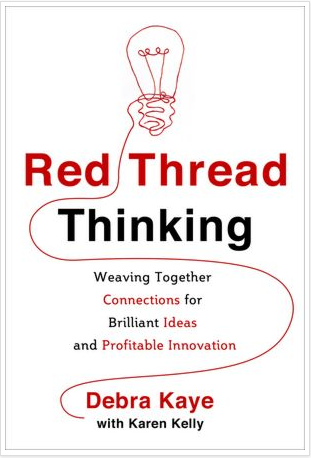
Starting with an argument for making innovation a regular part of life, as well as a little confidence building, Red Thread Thinking helps improve brain skills, creativity and innovation capacity no matter what life stage you’re in.
“Red Thread One: Innovation – It’s All in Your Head” synthesizes findings from the latest brain research and shows how to make your thinking sharper, clearer, unfettered and more imaginative. Believe it or not, there’s a fountain of youth in your head – an eternal deluge of new ideas can spring from your brain.
“Red Thread Two: Everything Old is New” demonstrates how to develop new relationships among a collection of existing parts – what you already have on hand and know about or can access – which can combine in new ways to innovate new products. Everyone thinks innovation is about the future and the book explains why it’s actually about what’s already present. Fact-finding and research crucial to the innovation process starts here.
“Red Thread Three: Consumers – The Strangest Animals at the Zoo” talks about behavior and culture and how to glean vital insights from observing consumers “on the job,” just living and doing what comes naturally, and how to leverage hidden cultural meanings that explain why consumers behave in certain ways.
What will surprise you is that you can make your innovation great, not by changing consumer behavior (which has been the futile goal of innovation for 40 years), but by playing into existing behaviors. More good news: you won’t need to out-spend and out-market the big guys because you are working within a consumer habit, not trying to break it.
“Red Thread Four: What You See Is What You Get” is about communicating an idea in a way that gives consumers an immediate picture of its point of difference. Iconography, the perfect reduction of information to a single, unmistakable sign that can be quickly communicated, seems to be the forgotten stepchild of design strategy, language and simplification. But iconography is where we are headed. Language will not be entirely obsolete but pictures will and have already started to play a larger role in communication. Learn how to create an entirely new language and simplify to the feature you want to highlight to create a story that is truly unique; then communicate in a way that can be universally understood. You’ll be amazed at the success of innovation that makes for simpler experiences and interactions.
“Red Thread Five: The Force of Passion” comes full circle in the innovation tour of duty: through doubts, outside naysayers, recognizing mistakes, making revisions, rethinking and retooling. When you come up with a new idea, lots of people are going to think you’re crazy. You have to listen carefully and know if the naysayers are simply being dismissive, or if they are identifying real problems. You have to learn to interpret, be willing to change, reinvent, revise and refine your idea. Without sustained passion, it can be difficult to absorb criticism with an open mind and a neutral perspective. If you can’t, you’ll kick yourself when someone else comes up with a similar idea and gets to market before you because they persevered until they found that one small breakthrough or the critical tweak that made the product work.


